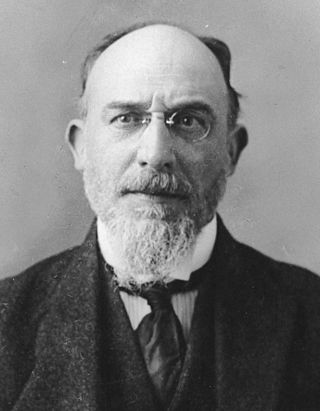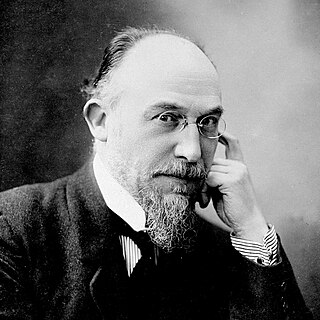External links
- Cheap Imitation (piano version) data sheet and discography at the John Cage database
- Cheap Imitation at UbuWeb Conceptual
| Music |
|
|---|---|
| Books |
|
| Depictions | |
| Related | |
Cheap Imitation is a piece for solo piano by John Cage, composed in 1969. It is an indeterminate piece created using the I Ching and based, rhythmically, on Socrate by Erik Satie.
Like numerous other works by Cage, Cheap Imitation was a result of his collaboration with Merce Cunningham's dance company. However, in this case the original choreography relied not on Cage's music, but on a piano arrangement of Erik Satie's symphonic drama Socrate . In 1947 Cunningham choreographed a dance based on the first movement of Satie's work, and Cage provided a two-piano transcription of the music (since Cunningham's dances were usually accompanied by piano only). In 1968 it was decided to expand the choreography by two movements, based on the remaining two movements of the Satie work. [1] Cage, who was at the time working on HPSCHD , a large multimedia work, requested help of an acquaintance from the University of Illinois, Arthur Maddox, and together they completed a two-piano arrangement of the remaining two movements. [2] The new choreography was to be premiered in early 1970.
However, in December 1969 Cage received news from Satie's publisher, Éditions Max Eschig, that he had been refused the rights to perform the piece, although Eschig hadn't even requested to see the transcription. Because the choreography was based on the rhythms and structure of Socrate, Cage could not simply compose a new piece of music. He decided to imitate Satie's work in a piano solo. [2] Cage titled the result Cheap Imitation, and Cunningham responded in kind, naming the choreography Second Hand. [1]
Cheap Imitation became the last work Cage performed in public as a pianist: arthritis prevented him from doing any more performances. Nevertheless, even though his hands were painfully swollen, he still played it during the 1970s. [3] Cage grew more and more fascinated with the piece, [4] producing transcriptions for orchestra of a minimum of 24 performers and a maximum of 95 (1972) and for solo violin (1977) at the request of the violinist Paul Zukofsky (who in 1989–90 also assisted Cage in completing the Freeman Etudes , which had been started in 1977–80). [5] The orchestral versions, however, were not performed until much later, because the musicians refused to rehearse and would subsequently discover the piece was too difficult for them. [6]
Cheap Imitation became something of a departure for Cage, because it was his first "proper" composition, in the old sense of the word, since 1962. [7] Furthermore, the open declaration of Cage's own feelings (about Satie's work) was something very unusual for his work, which was, since the late 1940s, almost entirely impersonal. Cage himself was well aware of the contradiction between the rest of his works and Cheap Imitation:
In the rest of my work, I'm in harmony with myself ... But Cheap Imitation clearly takes me away from all that. So if my ideas sink into confusion, I owe that confusion to love. ... Obviously, Cheap Imitation lies outside of what may seem necessary in my work in general, and that's disturbing. I’m the first to be disturbed by it. [8]
Cage's fondness for the work resulted in a recording of him performing it in 1976 – a rare occurrence, given Cage's negative attitude to recordings.
Cheap Imitation has three parts consisting almost exclusively of a single melodic line, with occasional doublings. The rhythmic structure of the phrases is based on Satie's original, usually on the vocal line, occasionally on the orchestral parts. The pitches were determined using chance operations with the I Ching , through the following questions:
Cage observed phrase and note repeats present in Satie's melodies, adding them to his imitation. The use of modes was unusual in that Cage used chromatic transpositions; the composer called Cheap Imitation a chromatic modal piece. [4]
The violin version, completed in 1977, was a collaboration with Paul Zukofsky. This transcription is transposed a major third higher than the original (otherwise several notes would be out of range of the instrument) and is identical to it, except for a few passages. [9]
Cage would subsequently write several more pieces based on other composers' works, similarly using chance procedures to alter the originals. These include several solos from Song Books (1970), "harmonies" from Apartment House 1776 (1976), Some of "The Harmony of Maine" (1978) and Hymns and Variations (1979).

John Milton Cage Jr. was an American composer and music theorist. A pioneer of indeterminacy in music, electroacoustic music, and non-standard use of musical instruments, Cage was one of the leading figures of the post-war avant-garde. Critics have lauded him as one of the most influential composers of the 20th century. He was also instrumental in the development of modern dance, mostly through his association with choreographer Merce Cunningham, who was also Cage's romantic partner for most of their lives.
4′33″ is a three-movement composition by American experimental composer John Cage. It was composed in 1952, for any instrument or combination of instruments, and the score instructs performers not to play their instruments during the entire duration of the piece throughout the three movements. The piece consists of the sounds of the environment that the listeners hear while it is performed, although it is commonly perceived as "four minutes thirty-three seconds of silence". The title of the piece refers to the total length in minutes and seconds of a given performance, 4′33″ being the total length of the first public performance.

Socrate is a work for voice and piano by Erik Satie. First published in 1919 for voice and piano, in 1920 a different publisher reissued the piece "revised and corrected". A third version of the work exists, for small orchestra and voice, for which the manuscript has disappeared and which is available now only in print. The text is composed of excerpts of Victor Cousin's translation of Plato's dialogues, all of the chosen texts referring to Socrates.
Stephen Whittington is an Australian composer, pianist, teacher and writer of music.
Paul Zukofsky was an American violinist and conductor known for his work in the field of contemporary classical music.
Music of Changes is a piece for solo piano by John Cage. Composed in 1951 for pianist and friend David Tudor, it is a ground-breaking piece of indeterminate music. The process of composition involved applying decisions made using the I Ching, a Chinese classic text that is commonly used as a divination system. The I Ching was applied to large charts of sounds, durations, dynamics, tempo and densities.

Sonatas and Interludes is a cycle of twenty pieces for prepared piano by American avant-garde composer John Cage (1912–1992). It was composed in 1946–48, shortly after Cage's introduction to Indian philosophy and the teachings of art historian Ananda K. Coomaraswamy, both of which became major influences on the composer's later work. Significantly more complex than his other works for prepared piano, Sonatas and Interludes is generally recognized as one of Cage's finest achievements.

Etudes Australes is a set of etudes for piano solo by John Cage, composed in 1974–75 for Grete Sultan. It comprises 32 indeterminate pieces written using star charts as source material. The etudes, conceived as duets for two independent hands, are extremely difficult to play. They were followed by two more collections of similarly difficult works: Freeman Etudes for violin (1977–90) and Etudes Boreales (1978) for cello, or piano, or both together.
String Quartet in Four Parts is a string quartet by John Cage, composed in 1950. It is one of the last works Cage wrote that is not entirely indeterminate. Like Sonatas and Interludes for prepared piano (1946–48) and the ballet The Seasons (1947), this work explores ideas from Indian philosophy.
Song Books is a collection of short works by John Cage, composed and compiled by the composer in 1970. It contains pieces of four kinds: songs, songs with electronics, directions for a theatrical performance, and directions for a theatrical performance with electronics. "Any of these may be performed by one or more singers."
Six Melodies is a collection of six pieces for violin and keyboard instrument by John Cage. It was composed in 1950, shortly after Cage completed his String Quartet in Four Parts. The work uses the same techniques: the gamut technique and the nested rhythmic proportions. First, a fixed number of sonorities is prepared, each created independently of the other. These sonorities are called gamuts. Sequences of gamuts are then used to create melodies with harmonic backgrounds that are in no way connected to functional harmony, which Cage sought to avoid. The collection of gamuts used in Six Melodies is nearly identical to the one used in the String Quartet. The structure of each piece, and that of each phrase, is defined by the same rhythmic pattern: 31⁄2, 31⁄2, 4, 4, 3, 4. The violinist is instructed in the score to play without vibrato and with minimum weight on the bow.
American avant-garde composer John Cage (1912–1992) began composing pieces for solo prepared piano around 1938–40. The majority of early works for this instrument were created to accompany dances by Cage's various collaborators, most frequently Merce Cunningham. In response to frequent criticisms of prepared piano, Cage cited numerous predecessors. In the liner notes for the very first recording of his most highly acclaimed work for prepared piano, Sonatas and Interludes, Cage wrote: "Composing for the prepared piano is not a criticism of the instrument. I'm only being practical." This article presents a complete list of Cage's works for prepared piano, with comments on each composition. All of Cage's indeterminate works for unspecified forces can also be performed on or with Prepared Piano.
The Seasons is a ballet with music by John Cage and choreography by Merce Cunningham, first performed in 1947. It was Cage's first piece for orchestra and also the first to use what Cage later called the gamut technique, albeit in an early form.
Music for Piano is a series of 85 indeterminate musical compositions for piano by American avant-garde composer John Cage. All of these works were composed by making paper imperfections into sounds using various kinds of chance operations.
Etudes Boreales is a set of etudes for cello and/or piano composed by John Cage in 1978. The set is a small counterpart to Cage's other etude collections - Etudes Australes for piano and Freeman Etudes for violin.
Sonata for Clarinet is an early work by John Cage, composed in 1933. It is also known under its early title, Sonata for One Voice.
Freeman Etudes are a set of etudes for solo violin composed by John Cage. Like the earlier Etudes Australes for piano, these works are incredibly complex, nearly impossible to perform, and represented for Cage the "practicality of the impossible" as an answer to the notion that resolving the world's political and social problems is impossible.

The Nocturnes are a set of five piano pieces by Erik Satie. They were written between August and November 1919. With the exception of the Premier Menuet (1920), they were his final works for solo piano, and are considered among his most significant achievements in the genre. The Nocturnes stand apart from Satie's piano music of the 1910s in their complete seriousness—lacking the zany titles, musical parody, and extramusical texts that he typically featured in his scores of the time. The completed set of five nocturnes takes about 13 minutes to perform.

The Premier Menuet is a Neoclassical piano piece by Erik Satie. Written in June 1920, it was his last composition for solo piano. It was published by Les Éditions de La Sirène in 1921.